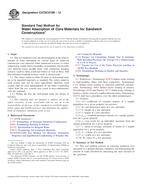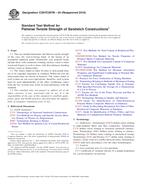We need your consent to use the individual data so that you can see information about your interests, among other things. Click "OK" to give your consent.
ASTM D7617/D7617M-11
Standard Test Method for Transverse Shear Strength of Fiber-reinforced Polymer Matrix Composite Bars
STANDARD published on 1.3.2011
The information about the standard:
Designation standards: ASTM D7617/D7617M-11
Note: WITHDRAWN
Publication date standards: 1.3.2011
SKU: NS-38834
The number of pages: 12
Approximate weight : 36 g (0.08 lbs)
Country: American technical standard
Category: Technical standards ASTM
The category - similar standards:
Annotation of standard text ASTM D7617/D7617M-11 :
Keywords:
bars, composite bars, composite materials, double shear, rebar, reinforcing bars, shear properties, shear strength, ICS Number Code 83.120 (Reinforced plastics)
Additional information
| Significance and Use | ||||||||||||||||||
|
This test method for transverse shear strength is intended for use in laboratory tests in which the principal variable is the size or type of FRP bars. The test may be used for smooth round rods or on bars with a textured or undulating surface added to promote bond of the bars to Portland cement concrete. This test method establishes values of transverse shear strength for material specifications, quality control, quality assurance, research and development, and may also be used for structural design purposes. Experience with this test method and the accompanying fixture is primarily with smooth rods and textured bars with diameters ranging from 6 mm to 25 mm [0.25 in. to 1 in.]. The method may be used for rods or bars of larger diameters, but the overall geometry of the test fixture may need to be increased. |
||||||||||||||||||
| 1. Scope | ||||||||||||||||||
|
1.1 This test method specifies the test requirements for (FRP) composite smooth round rods and textured bars for determining the transverse shear strength via a double shear fixture. FRP rods and bars are often loaded in transverse shear when these elements are used as dowels in concrete pavements, as stirrups in concrete beams, or as shear reinforcements in glued-laminated wood beams, for example. 1.2 The values stated in either SI units or inch-pound units are to be regarded separately as standard. The values stated in each system may not be exact equivalents; therefore, each system shall be used independently of the other. Combining values from the two systems may result in non-conformance with the standard. 1.2.1 Within the text, the inch-pound units are shown in brackets. 1.3 This standard does not purport to address all of the safety concerns, if any, associated with its use. It is the responsibility of the user of this standard to establish appropriate safety and health practices and determine the applicability of regulatory limitations prior to use. |
||||||||||||||||||
| 2. Referenced Documents | ||||||||||||||||||
|
Similar standards:
Historical
1.4.2011
Historical
1.4.2012
Historical
15.11.2011
Historical
1.10.2010
Historical
1.4.2009
Historical
1.8.2012
We recommend:
Technical standards updating
Do you want to make sure you use only the valid technical standards?
We can offer you a solution which will provide you a monthly overview concerning the updating of standards which you use.
Would you like to know more? Look at this page.



 ASTM C271/C271M-11..
ASTM C271/C271M-11.. ASTM C272/C272M-12..
ASTM C272/C272M-12.. ASTM C273/C273M-11..
ASTM C273/C273M-11.. ASTM C297/C297M-04(2..
ASTM C297/C297M-04(2.. ASTM C363/C363M-09..
ASTM C363/C363M-09.. ASTM C364/C364M-07(2..
ASTM C364/C364M-07(2..
 Cookies
Cookies
